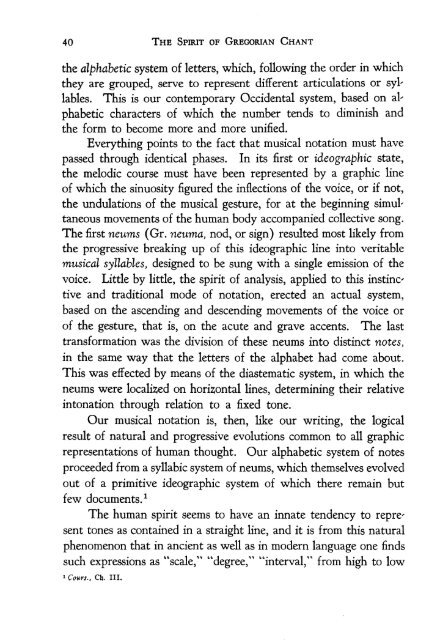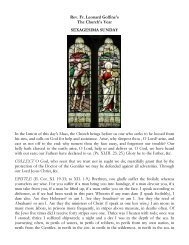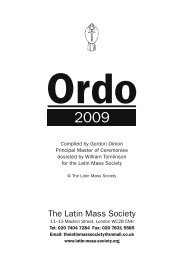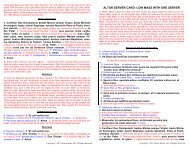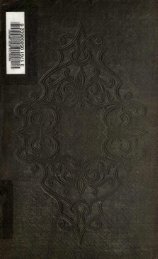The Spirit of Gregorian Chant - Church Music Association of America
The Spirit of Gregorian Chant - Church Music Association of America
The Spirit of Gregorian Chant - Church Music Association of America
Create successful ePaper yourself
Turn your PDF publications into a flip-book with our unique Google optimized e-Paper software.
40 THE SPIRIT OF GREGORIAN CHANT<br />
the alphabetic system <strong>of</strong> letters, which, following the order in which<br />
they are grouped, serve to represent different articulations or syllables.<br />
This is our contemporary Occidental system, based on alphabetic<br />
characters <strong>of</strong> which the number tends to diminish and<br />
the form to become more and more unified.<br />
Everything points to the fact that musical notation must have<br />
passed through identical phases. In its first or ideographic state,<br />
the melodic course must have been represented by a graphic line<br />
<strong>of</strong> which the sinuosity figured the inflections <strong>of</strong> the voice, or if not,<br />
the undulations <strong>of</strong> the musical gesture, for at the beginning simultaneous<br />
movements <strong>of</strong> the human body accompanied collective song.<br />
<strong>The</strong> first neums (Gr. neuma, nod, or sign) resulted most likely from<br />
the progressive breaking up <strong>of</strong> this ideographic line into veritable<br />
musical syllables, designed to be sung with a single emission <strong>of</strong> the<br />
voice. Little by little, the spirit <strong>of</strong> analysis, applied to this instinc<br />
tive and traditional mode <strong>of</strong> notation, erected an actual system,<br />
based on the ascending and descending movements <strong>of</strong> the voice or<br />
<strong>of</strong> the gesture, that is, on the acute and grave accents. <strong>The</strong> last<br />
transformation was the division <strong>of</strong> these neums into distinct notes,<br />
in the same way that the letters <strong>of</strong> the alphabet had come about.<br />
This was effected by means <strong>of</strong> the diastematic system, in which the<br />
neums were localized on horizontal lines, determining their relative<br />
intonation through relation to a fixed tone.<br />
Our musical notation is, then, like our writing, the logical<br />
result <strong>of</strong> natural and progressive evolutions common to all graphic<br />
representations <strong>of</strong> human thought. Our alphabetic system <strong>of</strong> notes<br />
proceeded from a syllabic system <strong>of</strong> neums, which themselves evolved<br />
out <strong>of</strong> a primitive ideographic system <strong>of</strong> which there remain but<br />
few documents. 1<br />
<strong>The</strong> human spirit seems to have an innate tendency to represent<br />
tones as contained in a straight line, and it is from this natural<br />
phenomenon that in ancient as well as in modern language one finds<br />
such expressions as "scale," "degree," "interval," from high to low<br />
i Cwrs., Cb. HI.


